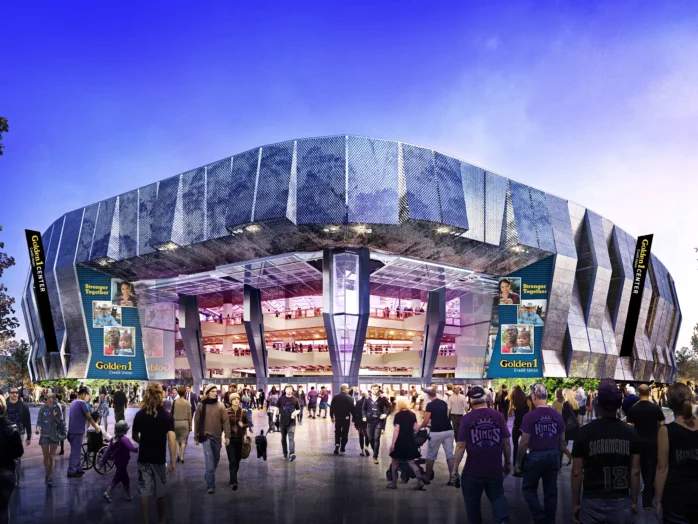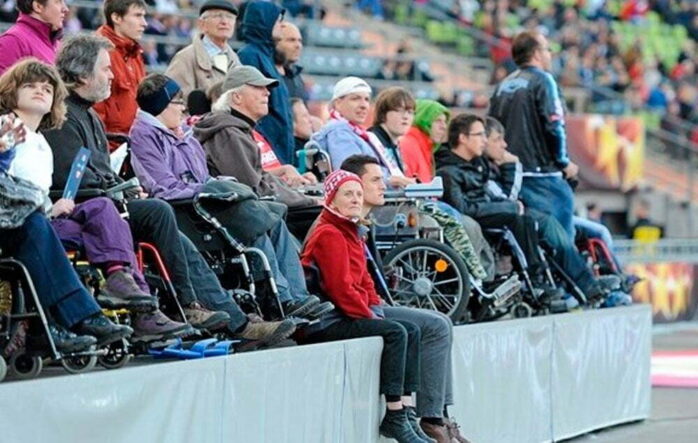
Stadiums are a place of magnificence. Whether it’s the atmosphere, the fans, the game’s high stakes or the players on the field… there is just something special about them. However, some stadiums lack that special something, and they need to find ways to create it. Check out our tips for boosting stadium fan engagement and boosting the bottom line.
The core elements of the ultimate fan experience – having a favourite team, cheering them on, and enjoying good game views – have remained the same since humans built the first sport arenas thousands of years ago.
However, despite the transformation of stadiums into entertainment and tourism destinations in recent years, stadiums currently face growing competition from new technology designed to bring the sights (and sounds) of live sports events into people’s homes.
Fans now have a more complete, immersive experience thanks to augmented reality/virtual reality (AR/VR) and multi-platform multimedia offerings. In addition to this, the financial cost and amount of time committed to attending a game remains high and has even increased for many clubs.

The result of this trend is that overall attendance at games has stalled or is seeing a steady decline.
According to Bilue clubs need to find new and innovative ways to boost fan engagement to keep fans coming to the stadium.
There are many ways in which stadiums can achieve this, but we will focus on three key methods which we believe will have the biggest impact:
- Enhancing the fan experience through technology
- Creating a more social atmosphere
- Providing easier access to in-game/in-venue content
Profitable ways to boost fan engagement in Stadiums that work

1. Enhancing the fan experience through technology
Technology has changed the narrative in almost every facet of our lives, and sports is no exception. Stadiums have been quick to adopt new technology to improve the fan experience and give them a sense of the action no matter where they are.
Following are some examples:
Augmented Reality and Virtual Reality (AR/VR)
There’s a growing trend in sports towards AR/VR technology, which is taking stadiums (and fans) by storm.
It complements traditional forms of watching a game, giving viewers a more in-depth look at the action.
AR/VR technologies can be used to add many features such as:
- Replays – offering fans access to unique angles and close-ups, including player profiles or in-depth analysis of plays. Fans can even recreate the play from an alternative perspective to better appreciate what happened on the field.
- Live Stats – providing real-time updates on players and team performances, statistics, and scores to keep fans fully up-to-date on the game.
- 3D Stadiums – letting fans see and explore a stadium in a completely new way, from different angles and vantage points.
The possibilities are endless and continue to grow as these technologies develop.

Stadiums need to adopt this technology to stay ahead of the curve and keep up with fans’ modern expectations.
So far, the uptake of AR/VR technology has been good, with more and more stadiums implementing it every year. A lot are developing mobile apps that are compatible with popular VR/AR headsets like Occulus.
We expect this trend to continue in the coming years as the technology becomes more refined and fans demand even more immersive experiences.
Some notable examples include Soccer (European Football) clubs like Juventus and Manchester City and American Football teams like the Dallas Cowboys.
In 2019, fans at the AT&T Stadium of the Dallas Cowboys were able to take photos with their favourite players simultaneously, as they were in action on the field thanks to augmented reality. Can you beat that for fan engagement?
The NBA is not left out too. In the 2019 season, they launched a VR initiative that allowed fans to see the playoffs from various panoramic camera angles while also providing real-time stats and on-demand replays.
As it becomes more mainstream, we can expect more stadiums and leagues to take this technology up in the coming years.
Mobile Applications

Mobile apps make life easier for sports fans. They can buy tickets, check-in for games, get directions to the stadium, and see real-time updates on what is happening at the game.
Consider your mobile app strategy as part of your overall marketing and fan engagement plan if you’re a sports team.
For fans at the stadium, the following are some ways sports teams can use mobile apps for fan engagement:
- Give fans a way to interact with each other.
- Provide a way for fans to vote on contests and activities.
- Give fans the ability to share what they are doing on social media if they want to do so.
- Give fans real-time updates on the game, including scoring and player stats.
- Sell tickets and merchandise.
- Collect fan feedback.
Make sure you design an app that is easy to use and provides valuable information to fans. You may also want to consider using push notifications to send real-time updates to fans’ phones.

If you use a mobile app to collect fan feedback, you can gather great information. You’ll be able to learn what your fans love most about the team and what they would like to see changed. Use this information to make your team even more successful.
A mobile app can also help you sell tickets and merchandise. If you make it easy for fans to buy tickets or purchase merchandise, they are more likely to do so. This can help boost your profits and make your fans happier.
Provide High-Tech Amenities
Stadiums have to provide a superior customer experience to stay ahead of the curve. One way they can create a unique fan experience is by incorporating high-tech amenities.
For example, Mercedes-Benz Stadium, home of the Atlanta Falcons and Atlanta United, has a “Halo Board” that is made up of a 360-degree video screen. This incredible board gives fans a never-before-seen view of the game. Additionally, state-of-the-art video and audio systems, wireless access points, and other amenities make the fan experience in Mercedes-Benz Stadium unlike any other.
Using these technologies can significantly boost in-stadium engagement and revenue by making games more fun and interactive. This presents multiple opportunities for clubs and brands to take advantage of.
2. Creating a more social atmosphere

Stadiums should consider taking notes from other entertainment venues which have successfully made their spaces more social and inclusive – such as movie theatres and concert venues.
One change implemented in many stadiums is the increase in standing-room-only areas, such as the popular ‘The Kop’ at Liverpool’s Anfield stadium. It allows more fans to be closer to the action and creates a more lively, energetic atmosphere.
In addition, stadiums could implement social gathering areas, such as bars and restaurants, that would allow fans to interact with each other before and after games. This strategy could generate additional revenue and help bring fans closer together.
Create exclusive experiences for premium ticket holders
Most sports teams offer different types of tickets with varying access and amenities. For example, a team may offer a general admission ticket, a VIP ticket, and a corporate box ticket.
Teams could further enhance the fan experience for those who purchase more expensive tickets by creating exclusive experiences for them. It could include providing access to special areas of the stadium, such as a luxury lounge or a private box. It could also include providing meet-and-greet opportunities with players or team officials or exclusive merchandise.
By creating these experiences, teams can make fans feel more special and appreciated, encouraging them to spend more money on tickets in the future.
Create a Fun and Festive Atmosphere

A festive atmosphere can also help to engage fans and keep them excited about the game. For example, some stadiums incorporate theme nights into their schedule to create a more festive atmosphere. That can be a great way to get fans excited about coming to the game and help to create a more lively atmosphere.
Stay on-side with Social Media
Sports teams need to embrace social media and incorporate it into their marketing strategy. This means that they should stay on top of current trends and adopt new technologies as they become available.
For example, many teams are now using Snapchat filters during games. It allows fans to interact with the team in a fun and unique way. Additionally, teams are using live-streaming platforms, such as Periscope and Facebook Live, to give fans an inside look at the team’s preparations for the game.
By using these platforms, teams can connect with fans more personally and create a deeper connection.
Social media can also help teams improve their game-day experience by creating online contests and promotions. For example, teams can announce trivia questions on social media and award fans with the correct answer special prizes at halftime – such as exclusive autographs or merchandise.
3. Providing easier access to in-game/in-venue content

One of the biggest obstacles that prevent fans from attending games is the lack of opportunity for pre-game and in-game engagement. It is a challenge that can be easily overcome by using technology to open up new channels for communication and provide fans with instant access to live-action.
Some stadiums now use large video screens to show highlights, replays, and other in-game content. It allows fans to stay engaged with the game even when they leave their seats. In addition, teams can use technology to create mobile apps that allow fans to stream live-game action, receive updates on their favourite players, and even order food and drinks from their seats.
Create Exclusive Content for Fans in attendance
One of the biggest issues that sports teams face is that fans often see their game-day experience as too similar to that of other fans. They feel disconnected from the team because they cannot forge a unique connection with it.
A way to combat this is by creating exclusive content for fans, including videos, photos, and articles that are only available to those at the stadium. For example, teams could create a video shown on the stadium’s big screen exclusively for fans in attendance.
By providing exclusive content, teams can help to create a stronger connection with their fans and make them feel more special.
Conclusion

Stadiums are an important part of the sporting experience, and they need to find ways to engage fans and keep them excited about the game. By providing high-tech amenities, unique and interactive seating, and using technology to enhance the game experience, stadiums can create a fan-friendly environment that will keep fans coming back for more.











